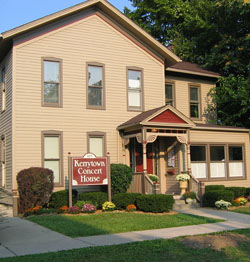
As those of you who regularly read my reports from Ann Arbor know, most of the new music I cover is related to the University of Michigan, usually in the form of a student composer concert, a performance by the resident Contemporary Directions Ensemble or the appearance of a contemporary work or two on a Symphony Band concert. Beyond these highly active groups at the Michigan School of Music, our town is gifted with two wonderful concert presenting organizations who regularly feature contemporary music on their programs: the University Musical Society and the Kerrytown Concert House. Last year I attended several UMS events, but hadn’t stepped inside KCH as an audience member until last week when composer Ezra Donner invited me to hear the Aurea Silva Trio premiere his work Variations for Flute, Bassoon and Piano.
More so than UMS, the Kerrytown Concert House focuses on experimental programming and intimate presentations, garnering recognition from the Nation Endowment of the Arts for their important role in the music community of Southeastern Michigan and, frankly, the whole country. Unbeknownst to me, KCH has hosted a new music/jazz festival called “Edgefest” for fifteen years, which wrapped up last month. Although, I missed out on an opportunity to report on that concert series, I was able to catch a bit of new music there last week with the aforementioned recital by the Aurea Silva Trio.
Commissioned for the Trio, Variations reflects a consistent theme in Mr. Donner’s music: the influence of his upbringing in the Rust Belt of western Pennsylvania. To my ears, the connection was apparent in the first, expansive sonority of the piece, which ascends from the rumbling depths of the bassoon’s lowest register to the higher ranges of the flute and the piano. This section is the theme of what Mr. Donner called a, “classically oriented theme and variations” in pre-concert remarks, and does more than establish the root of all the subsequent music, it introduces bassoonist Gareth Thomas as a very prominent figure in the narrative of the work. Beyond the structure, the only stylistic allusion to classical tradition occurs with one variation I noted as a, “demented waltz”. I found the link impossible to ignore thanks to the section’s typifying meter and accompanimental pattern in the piano, though the passage’s melodic material is more of a grotesque caricature of than a respectful homage to traditional waltz music. As the variations continue, the ‘waltz’ music returns in a decayed form while the bassoon maintains its status as the principle melodic figure in the work – until the theme comes back. With the bassoon relegated to its lowest range, pianist David Gililand and flutist Brandy Hudelson are given an opportunity to expand on what we’ve heard before, leading to a rousing conclusion that caused one attendee – luminary America composer William Bolcom – to call out “good!” before the Trio could take its first bow.





